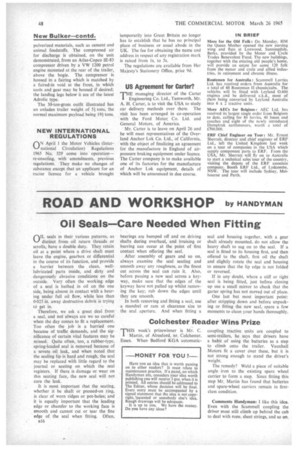Oil Seals—Care Needed When Fitting
Page 50

If you've noticed an error in this article please click here to report it so we can fix it.
(-AIL seals in their various patterns, as distinct from. oil return threads or scrolls, have a double duty. They retain oil at a point where a drive shaft must leave the engine, gearbox or differential in the course of its function, and provide a barrier between the clean, welllubricated parts inside, and dirty and dangerously abrasive conditions on the outside. Very often the working edge of a. seal is bathed in oil on the one side, being almost in contact with a bearing under full oil flow, While less than 0.025 in. away destructive debris is trying to get in.
Therefore, we ask a great deal from a seal, and not always are we so careful when the day comes to fit a replacement. Too often the job is a hurried one because of traffic demands, and the significance of certain vital features may be missed. Quite often, too, a rubber-type, spring-loaded seal is removed because of a severe oil leak, and when noted that the sealing lip is hard and rough, the seal may be replaced with little regard to the journal or seating on which the seal registers. If there is damage or wear on this seating face, the new seal will not cure the leak.
It is most important that the seating, whether it be shaft or pressed-on ring, is clear of worn ridges or pot-holes; and it is equally important that the leading edge or chamfer to the working face is smooth and cannot cut or tear the fine edge of the seal when fitting. Often,
al 6
bearings are bumped off and on driving shafts during overhaul, and bruising or burring can occur at the point of first contact when offering the seal.
After assembly of gears and so on, always examine the seal seating and smooth away any roughness, as the finest cut across the seal can ruin it. Also, before passing a new seal across a keyway, make sure that the edges of the keyway have not pulled up whilst removing the key; rub down the edges until they are smooth.
In both removing and fitting a seal, use a mandrel or ram at clearance size to the seal aperture. And when fitting a
seal and housing together, with a gear shaft already mounted, do not allow the heavy shaft to sag on to the seal. if a seal is fitted to its housing first, and then offered to the shaft. first oil the shaft and slightly rotate the seal and housing to ensure that the lip edge is not folded or reversed,
If in any doubt, where a stiff or tight seat is being fitted, just before closing up use a small mirror to check that the garter spring has not moved out of place.
One last but most important point: after stripping down and before unpacking or fitting the new seal, spare a few moments to clean your hands thoroughly.




























































































































